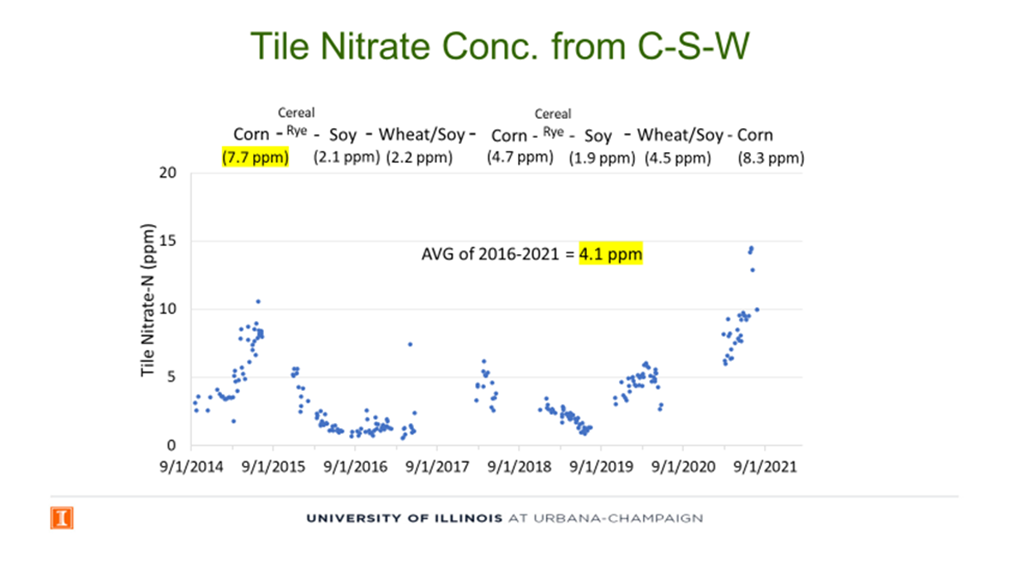During the September call of the Illinois Cover Crop On-farm Network (ICCON), Mr. Lowell Gentry shared his research and insights on the impact of a more diverse crop rotation on tile nitrate levels. Lowell, an agronomist who recently retired from the University of Illinois, has conducted research over the past 30 years investigating nitrogen (N) cycling in agricultural systems. He has extensive experience in monitoring nutrient runoff from agricultural fields and testing the effectiveness of various edge-of-field remediation practices.
Early on in his career, Lowell and his colleague Dr. Mark David identified a direct correlation between nitrate levels in tile drainage and nitrate levels in the Embarras River, an agriculturally dominated watershed (85% row crop) with little N input from sewage effluent or animal manure. Since 1993, the nitrate load in the Embarras River has averaged 27 lbs/A/yr; however, their data showed that nitrate wasn’t just being lost from unused fertilizer in corn fields, nitrate was being lost from soybean fields as well. From this research, Lowell identified that nitrate pollution is not entirely due to unused or excess nitrogen fertilizer – it often has to do with other factors like when the fertilizer is applied, when it rains, and other external factors (i.e. early spring temperatures).
In recent years, Lowell has been involved in on-farm research studies. In Douglas County a large, replicated tile drainage experiment was established in 2015 using 36 parallel tile laterals across one field. The experimental design allowed for 6 N treatments, with three replicates and both phases of the corn/soybean rotation each year. See data from this trial below:
Corn N treatments were: 1) 100% of a full N rate (160 lbs/A) applied in fall; 2) a 3-way split N application of 50% in the fall, 25% at planting, and 25% as an early side-dress; 3) 100% of full rate in the spring; 4) 75% of full rate in the spring; 5) a 2-way split N application of 50% in the spring and 50% as an early side-dress; and 6) same as #5 with cereal rye after corn and oat and radish after soybean. Cumulative loads are averaged across both crop phases each year.
From the cumulative load data, it is clear that fall N application led to greater tile nitrate loss than the other treatments; while the 50%/50% split N treatment with cover crops lost the least amount of nitrate to the tiles (more than 40% less tile nitrate for 50%/50%/Cover compared to 100% Fall).
During the call, Lowell pointed to mineralization as an important source of tile (and therefore river) nitrate, and demonstrated with his data that losing nitrate from mineralization following soybean production can be significant and has little to do with N fertilizer application to corn.

During a “4R Field Day” hosted at Eric Miller’s farm this fall, attendees walk across a field that has recently been strip-tilled.
Over the past 6 years, Lowell has worked with other University of Illinois researchers on Eric Miller’s farm in Piatt County, looking specifically at how a more diverse crop rotation can impact tile nitrate levels. Eric has implemented a corn – soy – wheat/soy rotation on nearly 200 acres with a typical, business as usual corn-soy rotation to serve as a control. Lowell’s research found that the average tile nitrate concentration for a corn-soy-wheat rotation with a cereal rye cover crop is nearly 50% less than the tile nitrate concentration coming from a corn-soy field, while maintaining yield and profitability. Data below shows the cropping sequence and the annual flow-weighted mean nitrate concentration of the tile in parts per million (ppm).

The average annual flow-weighted mean nitrate concentration was 4.1 ppm for the diverse rotation compared to 8.7 ppm for the conventional corn/soybean rotation over the past 6 years.
Lowell reminded the group that the Illinois Nutrient Loss Reduction Strategy has established a target of reducing total nitrogen loads in Illinois waterways by 45%, with an interim target of a 15% reduction by 2025. Based on Lowell’s data, Illinois has the ability to meet this goal by incorporating crop diversity across the landscape and continuing to advance the adoption of cover crops.
To learn more about Lowell’s research, visit the Illinois Nutrient Research and Education Council’s website, and to get in touch with any questions, reach out to Lowell Gentry at lgentry@illinois.edu
If you are interested in joining the Illinois Cover Crop On-Farm Network to learn about new research and hear from cover crop specialists across the Midwest, you can register for our monthly calls or join our google group by sending an email to hvanbeck@farmland.org.